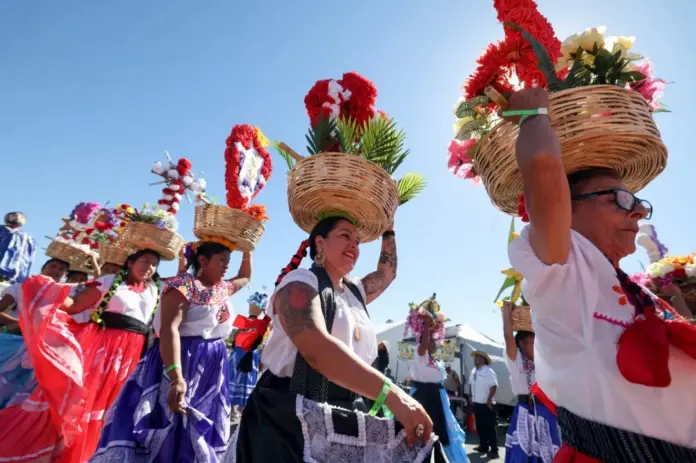
When Poway resident Jenny Martinez was a child living in Mexico, she first learned the traditional dances of her native Oaxaca. Years later, when she saw her mother dance the jarabe mixteco at events in the U.S., she wanted to do it again.
“I was so excited to see her,” said Martinez, a 26-year-old Head Start teacher. “So I started dancing, too.”
On Sunday, the colorful Guelaguetza festival returned to San Diego County for its 25th edition after a four-year hiatus due in part to the pandemic. Martinez was able to perform with her mother for the first time at the popular event, which was held in a parking lot at Palomar College in San Marcos.
“Not only is it fun, but it’s a way for me to connect with my culture and my roots,” she said.
The Guelaguetza, which comes from the Zapotec word “guendalezaa,” meaning offering or gift, is one of the most important traditions in Oaxaca, Mexico. In Oaxaca, the festival is held every year in July.
For people of Oaxacan descent living in the United States, this event is an opportunity to “preserve our culture and pass it on to the next generations,” said Valentín Ramírez, general coordinator of the Coalition of Indigenous Communities of Oaxaca, organizer of the festival.
The event, which organizers describe as “a festival of giving and sharing,” also showcases Oaxacan food, textiles and art.
Jenny and her mother, Micaela Martínez, are part of the SJS group, which is made up of residents or descendants of San Jerónimo Silacayoapilla, a small town in Oaxaca. “For us, it’s about teaching our children about our homeland, our dances and our music,” Micaela said.
Both had big smiles on their faces, proudly dressed in traditional colorful skirts, as they went to parade with other groups before their performances.
Each of the dances performed on stage represented one of the eight regions of Oaxaca. Seven of the dance groups were from San Diego County and one is from Los Angeles, Ramirez said.
For Oceanside resident Rossy Molano, the Guelaguetza is about bringing the community together. Molano performed with her husband and 19-year-old daughter.
“It’s like bringing a little piece of Oaxaca here,” she said. Molano, part of the group Calenda los Remedios de Valdeflores, said the members, whose ages range from 2 to 70, have become a kind of family. Ramirez said the Guelaguetza will return next year. “We want to continue doing this festival for the good of our community.”
Source: sandiegouniontribune






